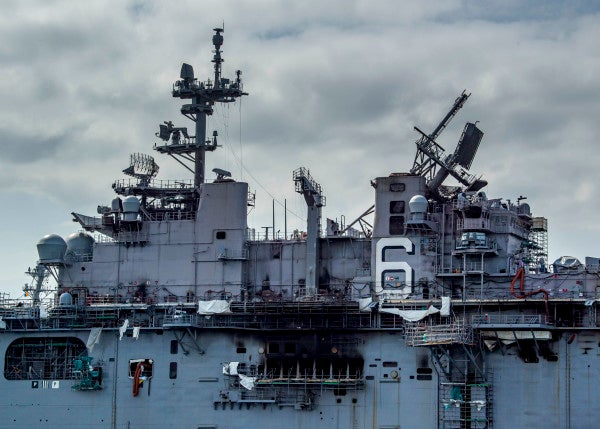The Bonhomme Richard fire raises concerns over whether the Navy can repair ships damaged in war
'There’s simply very few locations where someone could even attempt to build a replacement for Bonhomme Richard.'

While the damage to amphibious assault ship USS Bonhomme Richard is still being assessed, the best case scenario is that the ship will require several years of extensive repairs before it can return to sea.
Phil Ewing, a national security editor with NPR, pointed out that if it takes years to salvage vessels in peacetime, it is unlikely that the Navy could repair ships damaged in a war with China and Russia before the conflict ended.
“The assets you have on the First Day of the War in this era are likely the only ones you'll get and when they are broke, they go away; you are likely not going to get new ones or fix the current ones quickly enough to be relevant,” Ewing tweeted on July 14.

This issue touched a nerve for me. My grandfather served on the battleship USS New Mexico during World War II. The ship was hit twice by Kamikazes – the last attack was at Okinawa, where 36 U.S. ships were sunk and more than 350 other vessels were damaged.
At the time, America had the industrial muscle to not only repair ships damaged in battle but to also mass produce so many ships that the Navy could launch two amphibious operations on the opposite side of the globe within months of each other in 1944: France in June and the Philippines in October.
In fact, the U.S. Navy’s inventory of aircraft carriers grew from eight at the start of the war to 151 by 1945, said Peter Singer, of the New America think tank in Washington.
Related: The USS Bonhomme Richard has finally stopped burning
That meant that every time the Navy lost a carrier, it literally had another one in the pipeline ready to replace it, said Singer, who served on President Barack Obama's 2008 campaign.
Faced with a war against China or Russia, the United States would be unable to replace ships in those numbers or that quickly because technology and the economy have changed so much over the past 75 years, he said.
“We would be massively stretched to do battle repair at a scale like that, not just of ships, but also key systems like aircraft,” Singer said. “And that is if the adversary was kind and not throwing cybersecurity and supply chain issues at the repair yards (which, of course any thinking adversary would do).”
If a conflict with China or Russia broke out, the main factor that would limit the U.S. military’s ability to repair and replace ships that are as large as the Bonhomme Richard would be the fact that only a few dry dock facilities in the United States are large enough for Navy capital ships, said retired Navy Capt. Jerry Hendrix.
Related: USS Bonhomme Richard, its fate uncertain, would be one of largest ships Navy has lost outside of combat
“There’s simply very few locations where someone could even attempt to build a replacement for Bonhomme Richard,” Hendrix told Task & Purpose.
The Huntington Ingalls facility in Pascagoula, Mississippi is already busy building the America-class amphibious assault ship USS Bougainville and they have another ship slated to be built after that, he said. Newport News Shipbuilding in Virginia is already committed to building and maintaining the Gerald R. Ford-class aircraft carriers.
The only way the Navy could repair capital ships under wartime conditions would be to use commercial dry docks – and there are a lot fewer of those facilities than there were in 1945, Hendrix said.
Since World War II, the total number of dry docks in the United States that could be used for military ships has fallen from 50 to fewer than 20, said Hendrix. Under peacetime rules and regulations, the Navy would need between three and five years to be able to use all available commercial dry dock spaces, but that timeline could be accelerated in wartime.
Related: The Brits Found The Wreck Of A Continental Navy Warship. Now They're Plotting Their Revenge
Toward that end, a Navy working group named the Wartime Acquisition Scalable Plan has been discussing with U.S. companies for the past several years how they could rapidly increase shipbuilding if needed, said Navy spokesman Capt. Daniel Hernandez.
“This WASP planning effort looks at the U.S. industrial base (beyond the traditional defense companies) and its suppliers in order to meet the national defense strategy and the [Department of the Navy’s] readiness priorities to build and sustain a lethal naval force,” Hernandez said.
But warships today are far more technologically advanced than during World War II so repairs are much more complicated. Even under the best of circumstances, things can go wrong in shipyards. Work can take much longer than expected – or not be completed at all by the time a ship leaves the yard.
The best example of this conundrum is the never-quite finished aircraft carrier USS Gerald R. Ford, which has 11 uniquely designed weapons elevators that have for years been beset by technical problems.
As of Thursday, a total of 5 of the $13 billion aircraft carrier’s weapons elevators were working properly, Hernandez said.
Not getting the Pentagon Run-Down? Sign up here!
Jeff Schogol covers the Pentagon for Task & Purpose. He has covered the military for nearly 15 years and embedded with U.S. troops in Iraq and Haiti. Prior to joining T&P, he covered the Marine Corps and Air Force at Military Times. Comments or thoughts to share? Send them to Jeff Schogol via email at schogol@taskandpurpose.com or direct message @JeffSchogol on Twitter.
